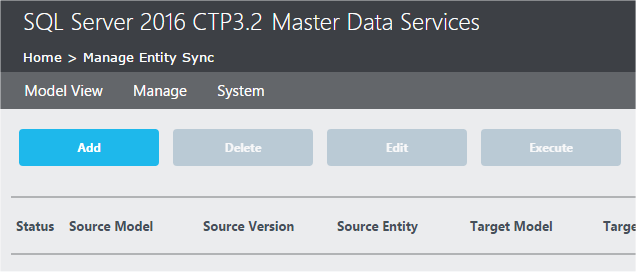Master Data Services 2016 now supports the ability to create
a Master Entity, and use it in all your models. It's called Entity Sync.
Master Data Services supports the concept of Models, and the
documentation encourages the use of multiple models for your different data
groups, such as products, customers, etc. All well and good, except that many
of those models use the same entity. A key tenant for a master data repository should include the
ease with which data can be sourced from a master location. Yet, within the
previous versions of MDS, reusing a core entity across multiple models was not
supported natively. You had to create
custom SSIS packages, or some other band-aid approach.
Entity Sync
As part of the System Administration, you now have a new
item under the Manage menu - Entity Sync.
Add/Edit
Using the Add/Edit button, you are presented with a form on the
right that allows you to select the source Model, Version and Entity, along
with the destination Target Model and Version. Plus the ability to push it to
either an existing entity or a new one, the name for the new entity and the
frequency the data is synced.
Is Sync Target
Once you have setup a entity to be sourced from a master
entity, it is flagged as "Is Sync Target" on the main entities page
for the target Model. Under the property listed "Is Sync Target"
you'll find the "yes" flag.
Copy of Data
When you setup an Entity Sync, keep in mind that the target
entity is physically created. And the data is only updated when the last
successful sync was run - again based on the refresh frequency properties. And finally, if you remove the Entity Sync process, the Entity initially created still exists.
Domain Controlled Attributes need not apply
If your source entity has any attributes that are driven by a domain (table) in the model, that attribute will not be included in the sync. No values are transferred over to the target. So, if you are trying to create a sophisticated model, using domains to manage your entity, this feature comes up a bit short. A nice start, but still incomplete. Still, if you can limit your master entities to only those that do not rely on another domain, this is a great addition.





2 comments:
XLNet is an integral part of machine learning. This article is amazing and very informative about XLNet technologies. There are many machine learning services that are now using this technology to keep the process simplified and easy.
As the growth of Big data consulting services , it is essential to spread knowledge in people. This meetup will work as a burst of awareness.
Post a Comment